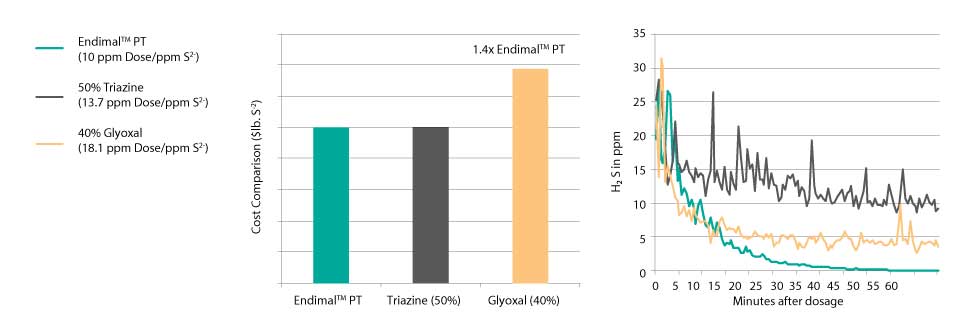Chlorine Dioxide for Wastewater Deodorization
The formation of hydrogen sulfide (H2S) often poses a problem for municipal wastewater treatment. Endimal™, a powerful deodorizing oxidant, can be effectively used to control noxious, irritating, or pungent odors from many operations. Moreover, its unique selective properties permit more efficient application at a lower dosage and cost than chorine, hypochlorite, permanganate, hydrogen peroxide or ozone.
Endimal™ SH, PT and DW oxidizing deodorizer products
Endimal™ is a proven proprietary solution formulated to destroy numerous odor-causing pollutants that are found in wastewater treatment systems. Endimal™ is uniquely designed to selectively react with sulfide compounds in the waste stream. As a result, Endimal™ requires a low applied dose which, in turn, provides an economically attractive solution with odor destruction capabilities that outperform other popular alternatives. Additionally, its oxidizing performance does not change with pH levels, thus providing high sulfide removal efficiencies.
Endimal™ serves a critical role in addressing odor control requirements with many positive attributes:
- Reduced corrosion
- No discharge of harmful by-products to the atmosphere
- Easily adjusted dosage to meet the rapidly changing odor demands with instantaneous results
- Eliminates sulfide-based odors
- Compatible with existing treatment regiment
- Does not interfere with composting activity
- Easily incorporated into all the dewatering techniques
- Cost-effective
- Facilitates a safer working environment
Reducing Common Industry Challenges
The challenges associated with hydrogen sulfide (H2S) gas emissions are of great concern in many industrial operations. The operational and safety consequences resulting from the presence of H2S can have a lasting negative impact on your business if not adequately addressed with an effective treatment solution. The real and present danger of H2S is driving many industries to look for a better alternative solution to the traditional H2S chemistries on the market today such as potassium permanganate and hydrogen peroxide.
The Endimal™ family of products has advantages over traditional oxidative and scavenging chemistries for H2S control. Endimal™ is a highly selective oxidant resulting in lower dosages and favorable economics. It is extremely fast acting and will not halogenate organics, form volatile organic compounds (VOCs), or interfere with other treatment processes at typical use levels.
Endimal™ PT is a faster-reacting, proprietary-blended product for treating sulfides in the aqueous phase. It is a DOT nonhazardous solution.
When compared to traditional H2S scavengers, the graph below shows that to achieve comparable H2S reduction, Glyoxal is 1.4x the treatment cost of Endimal™ PT. Further, although comparable in treatment costs, Triazine is less effective at H2S reduction than Endimal™ PT. Also demonstrated, Endimal™ PT provides faster reaction times, as well as superior sulfide and H2S reduction, compared with both Triazine and Glyoxal.

Features
- Faster removal of H2S from produced water
- Competitive cost position vs. likely alternatives due to selectivity of the chemistry
- Ease of application due to drum and pump simplicity
- DOT non-hazardous for transportation purposes
Benefits
- Increased productivity vs. NIK competition
- Reduced cost of application by as much as 65% when compared to typical chemistries
- No specialized equipment, fewer safety hazards, peace of mind for operators and site foreman
- More shipping options when sending to remote locations (cost, availability)
Wastewater Disinfection
Chlorine dioxide’s effectiveness is not limited to just odor-related problems. When used in water disinfection, it does not form chlorinated or brominated by-products, such as trihalomethanes (THMs) or haloacetic acids (HAAs), both of which cause concern for health and will soon come under strict regulatory limits. Use of chlorine dioxide as a disinfectant is already approved and used by the U.S. EPA Office of Drinking Water.
Lift Stations
Endimal™ oxidizing deodorizer compound effectively addresses lift station odor complaints from neighboring communities and improves workspace air quality for employees. It also reduces H2S corrosion problems.
Phenol Destruction
Chlorine dioxide is very effective at the destruction of phenol, converting it to benzoquinone and hydroquinone, which are environmentally benign. The reaction is fast, but pH dependent. Dosages range from 1.5 ppm ClO2/ppm phenol at pH less than 10.0 to 3.3 ppm ClO2/ppm phenol for pH greater than 10.0.
H2S
Chlorine dioxide and sodium chlorite can rapidly oxidize H2S in sour water streams before they have the chance to off-gas and create exposure dangers. This quickly eliminates the H2S hazard at the source rather than using sorbents or masking agents, which will lose efficiency over time and perhaps not even remove the local H2S inhalation hazard.
In addition, H2S is often generated from sulfate reducing bacteria (SRB) present in the water or sludge stream being treated. ClO2 is especially effective at killing these bacteria and eliminating the source of additional H2S.
We appreciate your interest in International Dioxcide. Take a moment to request additional information about our products and services.

